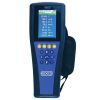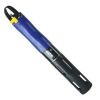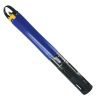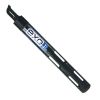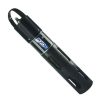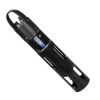YSI EXO1 Multi-Parameter Water Quality Sonde
Features
- Titanium sensors with wet-mateable, universal sensor ports
- Compact sonde fits in 2" diameter groundwater wells
- Smart QC automatically checks for faults and errors to ensure successful deployments
- Expedited repair and warranty service
- Lifetime technical support
- More
Modern and Efficient Design
The YSI EXO represents an advanced sonde platform that offers a wide range of capabilities to those dedicated to monitoring natural aquatic environments such as oceans, estuaries, rivers, lakes, and groundwater. The EXO1 sonde includes four sensor ports (sensors sold separately) with internal data logging and battery power.
Multi-Port Water Quality Sonde
- Temperature
- Conductivity
- Depth
- Dissolved oxygen
- pH
- ORP
- Total algae (phycocyanin or phycoerythrin along with chlorophyll)
- Turbidity
- Fluorescent dissolved organic matter (fDOM)
- Rhodamine WT
- UV nitrate
- ISE ammonium
- ISE nitrate
- ISE chloride
Outputs Four Calculated Parameters.
- Salinity
- Specific conductance
- Total dissolved solids (TDS)
- Total suspended solids (TSS)
Onboard Signal Processing and Memory
All EXO sensors are digital sensors with on-board signal processing and memory. Built-in sensor diagnostic and calibration data allow users to calibrate multiple sensors in one sonde and distribute to various other sondes in the field. Wet-mateable connectors allow for swaps in wet conditions, while active port monitoring automatically detects each sensor and verifies operation.
EXO1 Specifications
Diameter: 4.70cm (1.85 in)
Length: 64.77cm (25.50 in)
Peripheral Ports: 1 power communication port
Sensor Ports: 4
3-Year Warranty: Sonde; handheld
2-Year Warranty: Cables; conductivity/temperature and optical sensors; electronics base for pH, pH/ORP, ammonium, chloride, and nitrate sensors
1-Year Warranty: Optical DO cap and replaceable reagent modules for pH and pH/ORP sensors
3-Month Warranty: Replaceable reagent modules for ammonium, chloride, and nitrate sensors
Weight: 1.42kg (3.15 lbs)
General Sonde Specifications
Battery Life: 90 days**
Computer Interface: YSIP via USB Signal Output Adapter (SOA) and Bluetooth
Output Options: RS-232 & SDI-12 via DCP-SOA; Modbus & RS-485 via Modbus-SOA
Data Memory: 512 MB total memory; >1,000,000 Logged readings
Depth Rating: 0 to 250m (0 to 820 ft)
Sample Rate: Up to 4 Hz
Operating Temperature: -5 to +50°C (23 to 122°F)
Storage Temperature: -20 to +80°C (-4 to 176°F)
**Typically 90 days at 20˚C at 15-minute logging interval; temperature/conductivity, pH/ORP, DO, and turbidity sensors installed on EXO1; or temperature/conductivity, pH/ORP, DO, total algae, and turbidity sensors installed with central wiper that rotates once per logging interval on EXO2. Battery life is heavily dependent on sensor configuration.
- (1) EXO1 sonde
- (1) Probe guard
- (1) Calibration cup
- (1) Tool kit
- (2) Port plugs
- (2) D-cell alkaline batteries
- (1) USB drive loaded with manual & KOR Software
In The News
Rebuilding Trust in Science and Protecting Resources: Thomas More University Biology Field Station
Many universities and environmental organizations have field stations where monitoring equipment is deployed, and various environmental restoration initiatives are conducted. One example is the Thomas More University Biology Field Station . The Field Station is managed by a team of students, faculty, and staff who facilitate ongoing restoration and monitoring programs. Molly Williams is the Station Manager of the facility and spends her days overseeing various research projects, internships, and outreach initiatives. Having been an intern with the Field Station in 2021, Williams was excited to return as the Field Station Manager in 2023. Williams' initial time at the Field Station as an intern confirmed her decision to switch from a pre-med track to the field of ecology.
Read MoreFrom the Tap: Source Water Monitoring for Public Health
In regions with historically secure access to clean drinking water, few think about the work that goes into ensuring that the water they fill their cups with is safe. In reality, millions of dollars are invested in the infrastructure, equipment and teams involved in converting source water into drinking water. While all the work that goes into providing clean water often goes unnoticed, analysts like Michele Gilkerson, a water research analyst with the City of Columbus Division of Water, know exactly how much goes into securing safe water for millions of people. Gilkerson started with Battelle Memorial Institute in 1991 in their water ecology section. There, she saw how interesting source water monitoring could be, even though it isn’t often spotlighted in the environmental sector.
Read MoreMonitoring Water Pollution in Keweenaw Bay
As much as climate change and pollution impact current generations and present environmental conditions, the compounding damages will continue to wreak havoc against generations to come if no actions are taken. This idea is central for scientists who focus their research on monitoring, analyzing and responding to environmental data. Researchers like Dylan Friisvall, the water quality technician for the Keweenaw Bay Indian Community (KBIC) Natural Resources Department (NRD) , have dedicated their careers to monitoring pollution and water quality in order to protect resources for the future. “One of the best parts of my job is just being outdoors, it makes my day go by faster because I get to enjoy the fresh air, and help do my part in protecting the environment,” says Friisvall.
Read More


















































